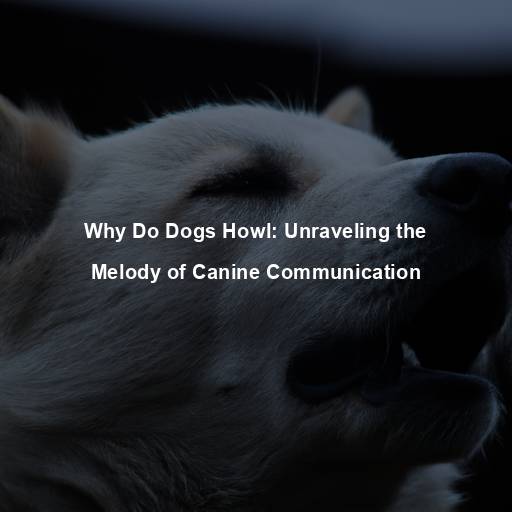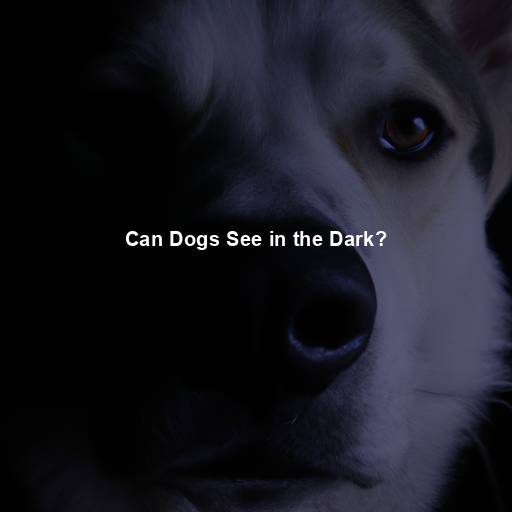Why Do Dogs Howl: Unraveling the Melody of Canine Communication
Last Updated on July 8, 2023 by Evan
Contents [hide]
- 1 The Enigmatic Howl: A Mysterious Melody
- 2 A Primitive Song: The Ancestral Call
- 3 The Language of Howls: What Are They Saying?
- 4 Decoding the Howl: Understanding Canine Communication
- 5 Embracing the Melody: Our Role in a Dog’s Howl
- 6 The Haunting Melody Continues: A Forever Mystery
- 7 The Howl’s Tale: Cultural Significance and Symbolism
- 8 The Howl as a Call to Action: Practical Considerations
- 9 A Symphony of Understanding: Embracing the Howl
- 10 Howling Across the Ages: Evolutionary Perspective
- 11 Howling: Nature vs. Nurture
- 12 A Melodic Language: Interpreting the Howl
- 13 Celebrating the Howl: Embracing Canine Individuality
- 14 FAQs – Why Do Dogs Howl
The Enigmatic Howl: A Mysterious Melody
Dogs, our faithful companions, have an uncanny ability to communicate with humans and fellow canines alike. Among the various forms of canine communication, the haunting and melodic howl stands out as a captivating and enigmatic vocalization. It is a sound that can evoke curiosity, wonder, and even a touch of melancholy. But why do dogs howl?
A Primitive Song: The Ancestral Call
### Ancestral Echoes: The Howl’s Origins
Unlocking the enigma behind a dog’s resonant howl requires us to embark on a captivating voyage into the labyrinthine corridors of their ancestral lineage. Descendants of the mighty wolves, our beloved canine companions bear an ethereal connection to their untamed forebears. Proficient in harmonious symphonies of sound, wolves utilize vocalizations as the glue that binds their cohesive packs, orchestrates their collaborative hunts, and demarcates their sacred territories. Hence, the resounding howl reverberating through the ages serves as a compelling testament to the ancient cadence ingrained within the DNA of our domesticated canids, artfully echoing the primitive language of their ancestry.
### Soulful Serenade: Emotional Expression
Beyond its ancestral origins, the howl serves as a means of emotional expression for our beloved furry friends. Dogs, being highly social creatures, use their vocalizations to convey a range of feelings. A howl can express loneliness, anxiety, or even sheer delight. It is a soulful serenade that tugs at our heartstrings, beckoning us to decipher its underlying message.
The Language of Howls: What Are They Saying?
### The Call of the Pack: Social Connection
In the wild, wolves howl to communicate with their pack members over long distances. Similarly, domesticated dogs may howl to establish contact with their human companions or other dogs nearby. It is their way of expressing a desire for social connection, a call that echoes across the neighborhood, seeking companionship and reassurance.
### Melancholy Melody: Loneliness and Separation Anxiety
Loneliness and separation anxiety are often cited as primary triggers behind a dog’s soulful howling. These four-legged companions thrive on social interactions, and when deprived of human company for prolonged stretches, they find themselves engulfed in a state of desolation and unease. The haunting cadence of their melodic howl becomes an enchanting means to convey their profound longing for companionship, a plaintive cry that echoes the depths of their affection and the warmth of familial bonds.
### Harmonic Hounds: Joining the Chorus
The enchanting allure of our furry friends lies in their uncanny knack for tuning into the symphony of sounds that surround them. From distant sirens to the cheerful barks of fellow canines, dogs effortlessly lend their melodious voices to the communal chorus. This harmonious celebration of their shared heritage not only showcases their extraordinary auditory prowess but also serves as a testament to their deep-rooted connection with one another.
Decoding the Howl: Understanding Canine Communication
### The Power of Pheromones: Scent Communication
Canine communication extends beyond vocalizations. Dogs also rely on scent-based communication to convey messages. When a dog howls, it can release pheromones that carry additional information to other dogs. These chemical signals can communicate anything from territorial boundaries to reproductive readiness, enhancing the effectiveness of the howl as a means of communication.
### Barking vs. Howling: Vocal Variations
While barking and howling are both vocalizations used by dogs, they serve different purposes. Barking is often associated with immediate and specific communication, such as alerting to potential threats or expressing excitement. Howling, on the other hand, tends to be a more prolonged and far-reaching form of communication, often used to convey broader messages or emotions.
### Context Matters: Environmental Triggers
The enigmatic world of a dog’s howl unveils itself when we unravel the mysterious threads of its context. From sirens to symphonies, canines fashion their vocal expressions around a myriad of environmental cues. Embedded within these cryptic bursts of sound lie echoes of their primal roots and personal narratives, bestowing upon their howls a tapestry of significance.
Embracing the Melody: Our Role in a Dog’s Howl
### Empathy and Companionship: Meeting Emotional Needs
As guardians of these incredible creatures, it is our responsibility to meet their emotional needs. When our dogs howl, it is essential to approach their vocalizations with empathy and understanding. Addressing their underlying emotions, such as loneliness or anxiety, through companionship, play, and mental stimulation can help alleviate their distress and create a harmonious bond between human and canine.
### Seeking Professional Guidance: Separation Anxiety
When it comes to our furry friends, deciphering their howls can be quite the conundrum. Should we be concerned when their vocalizations reach new heights? The answer, my dear readers, lies in the perplexing world of dog behavior. Excessive howling, if accompanied by distress signals, may indicate a deeper issue such as separation anxiety.
The Haunting Melody Continues: A Forever Mystery
The enigmatic allure of the canine howl remains an enduring puzzle, intertwining with our everyday existence and leaving us captivated by its inexplicable nature. From the heartfelt harmonies that echo under the shimmering moonlight to the collective chorus that harmonizes with the world’s symphony, the indelible presence of the howl is ingrained in the very essence of being a dog. Through our unwavering devotion to these faithful companions and our tireless exploration of their intricate means of communication, let us embrace the melodious cadence of their howls, allowing ourselves to revel in the awe-inspiring bond forged between humans and dogs.
The Melodic Influence: Music and Howling
The influence of music on dogs and their howling is a fascinating area of study. Research suggests that certain types of music can elicit a response from our canine companions, leading them to howl along or exhibit other behavioral changes. While individual dogs may have different preferences, classical music, in particular, has been found to have a calming effect on dogs, reducing stress and anxiety. This connection between music and howling sheds light on the profound impact that auditory stimuli can have on our furry friends.
A Howling Duet: Dogs and Musical Instruments
When it comes to music, our four-legged companions often surprise us with their unexpected fascinations. We all know that dogs have a knack for barking along to their favorite tunes, but did you know that they can also develop a peculiar interest in musical instruments? From the enchanting melodies of a piano to the soulful strumming of a guitar, these furry friends can’t help but be captivated by the unique sounds these instruments produce. Witnessing the harmonious symphony between a musician and a howling dog is a true testament to the intricate bond between sound, emotion, and the mysterious ways our canine friends communicate.
The Howl’s Tale: Cultural Significance and Symbolism
A Cultural Symphony: Howling in Folklore and Mythology
For generations, the haunting howl has woven itself into the very fabric of human myth and legend. Across countless cultures, this eerie sound has become intertwined with whispers of mysterious beings and otherworldly creatures. Take the werewolf, for instance, an iconic figure who unfurls its hidden nature under the moon’s watchful gaze, unleashing a bone-chilling howl that echoes through the night. Such is the captivating power of the howl, illuminating our enduring fascination with the enigmatic realms beyond our understanding.
The Wolf’s Cry: Symbol of Freedom and Wilderness
The howl has also come to symbolize the untamed spirit of the wilderness and the pursuit of freedom. Wolves, as the ancestors of our domesticated canines, epitomize this symbolism. Their howls echo through vast landscapes, carrying a message of unity, resilience, and the unyielding spirit of nature. By extension, our dogs’ howls can serve as a reminder of the wildness that still resides within them, a connection to a time when survival depended on the strength of the pack.
The Howl as a Call to Action: Practical Considerations
Respecting Neighbors: Minimizing Disturbance
When it comes to the melodious symphony of howls, dogs and their human sidekicks certainly have a deep connection. However, it’s crucially important to remember that our canine choruses can sometimes create a bit of a ruckus for the folks next door. To avoid any inter-species spats, it’s best to have an open dialogue with our neighbors, explaining the reasons behind our four-legged friends’ passion for vocalization, and finding ways to keep the decibel levels in check. Investing in some top-notch training techniques, coupled with ample mental and physical stimulation, can work wonders in curbing those excess howls and fostering harmony within our furry-friendly communities.
The Role of Training: Modifying Howling Behavior
When it comes to our furry companions, training is a real game-changer in shaping their behavior, especially when it comes to those melodious howling tendencies. With the power of positivity, we can unleash the potential to redirect our dogs’ vocal outbursts and create a serene haven for all. Don’t howl in despair – seek the guidance of professional trainers and behaviorists who can customize strategies to tackle your unique howling scenarios, ensuring a harmonious and successful training journey.
Seeking Veterinary Advice: Medical Causes of Howling
In some cases, howling may be a symptom of an underlying medical condition. Pain, discomfort, or cognitive decline associated with conditions like arthritis, injury, or cognitive dysfunction syndrome (CDS) can manifest as increased vocalizations, including howling. If a dog’s howling patterns change suddenly or if there are other concerning symptoms, seeking veterinary advice is crucial to rule out any potential health issues and provide appropriate treatment.
A Symphony of Understanding: Embracing the Howl
The Beauty of Canine Individuality: Embracing Differences
Like snowflakes falling from the sky, each dog possesses a distinctive personality that sets them apart from the pack. Just as the wind whispers secrets to the trees, their howling tendencies unveil a tapestry of complexity. The symphony of their voices echoes the intricacies of their breed, temperament, and personal experiences. By embracing this amalgamation of howls, we gain insight into the depths of their communication and forge an unbreakable bond with our four-legged confidants.
The howl has captivated our hearts and minds for centuries, evoking a range of emotions and inspiring a sense of wonder. As we unravel the secrets behind why dogs howl, we embark on a journey of discovery, deepening our understanding of these remarkable creatures. Whether it be a mournful cry, a joyous serenade, or a harmonic chorus, the howl continues to weave its melody into the tapestry of our lives, reminding us of the profound connection we share with our canine companions. Let us embrace the howl, listen to its symphony, and cherish the everlasting bond between humans and dogs.
Note: The content provided in this article is for informational purposes only and does not substitute professional veterinary advice. If you have concerns about your dog’s behavior or health, please consult with a qualified veterinarian or animal behaviorist.## The Power of the Pack: Social Dynamics of Howling
A Harmonious Connection: Howling as a Unifying Force
Howling is not only a means of communication for individual dogs but also serves as a unifying force within a pack. When one member of a pack initiates a howl, others often join in, creating a symphony of voices that strengthen social bonds and reinforce the pack’s unity. This synchronized howling not only establishes a sense of belonging but also serves as a powerful tool for coordination during hunts or territorial defense.
The Ripple Effect: Howling’s Influence on Other Dogs
There’s something enchanting about the resonating melody of a howl, reaching far beyond the confines of a tight-knit pack. It’s not uncommon for neighboring canines to join in, seemingly compelled by an invisible force. This ripple effect of sound speaks volumes about the contagious allure of a canine’s cry and the remarkable bond that exists between four-legged companions. It’s a primitive connection that defies the limits of individuality, unveiling the true might of doggy communication.
Howling Across the Ages: Evolutionary Perspective
The Survival Advantage: Howling for Survival
Howling, an age-old ritual of canines, holds a profound evolutionary purpose that bolsters their survival skills. Acting as an intricate system of long-range communication, this haunting vocalization enables wolves and other members of the canine family to uphold unity within their packs, define territorial limits, and synchronize their hunting endeavors. As a fascinating inheritance from their ancestors, our beloved domestic dogs embrace this primal trait, seamlessly integrating it into their behavioral spectrum. The enigmatic allure of howling persists, a testament to the enduring complexities of the natural world.
An Echo of the Past: Howling as a Link to Ancestors
The eerie sound of a howl echoing through the night transports us to a primeval world, where the bond between dogs and their predecessors was forged. A profound connection binds our domestic companions to the untamed wolves of yore, and their howling serves as a reminder of their wild heritage. It is in those haunting cries that we glimpse the untamed spirit within them, an ancient echo reverberating through time, reminding us of the primal power that once ensured the pack’s survival.
Howling: Nature vs. Nurture
Innate or Learned: The Origins of Howling Behavior
The mystical allure of a dog’s howl is a perplexing symphony that echoes through time, blending the intricate tapestry of innate traits and learned behaviors. Deeply ingrained in their genetic makeup, the ancient instinct to vocalize transcends mere barks and embraces the haunting beauty of the howl. As puppies embark on their journey of canine existence, their inquisitive minds absorb the mesmerizing melodies curated by their littermates and mother, sparking a symphony of imitation. Yet, the enigmatic orchestration of their howling tendencies is not solely crafted within the confines of familial bonds, for it is the harmonious interactions with other dogs, the enigmatic embrace of their environment, and the enigmatic dance with humans that blend together in a burst of melodious unpredictability.
A Melodic Language: Interpreting the Howl
Pitch, Duration, and Intensity: Clues to the Message
The enigmatic language of howling encompasses a myriad of meanings, intricately woven within its pitch, duration, and intensity. When the pitch ascends to the heavens, it often denotes fervent exhilaration, while a deeper resonance may signal anguish or solemnity. The length and fervor of this primal communication play a crucial role in unraveling its enigmatic message, as sustained and impassioned howls may signify a heightened state of being or a call for connection. By attuning ourselves to these cryptic variations, we unveil a portal to the emotional realm of our canine companions, enabling us to navigate their needs and emotions with enlightened awareness.
Emotional Context: Understanding the Situation
To fully understand a dog’s howling, it is vital to consider the emotional context in which it occurs. Dogs may howl in response to a variety of situations, such as separation anxiety, fear, excitement, or even as a form of communication with other dogs or humans. By observing the circumstances surrounding the howling episode, such as body language and environmental triggers, we can better interpret the underlying message our dogs are trying to convey.
Celebrating the Howl: Embracing Canine Individuality
The Unique Voice: Embracing Canine Individuality
Each dog possesses a unique voice, both literally and metaphorically. Just as humans have distinct speaking voices, dogs have their own variations in howling patterns, pitch, and vocalizations. Embracing this individuality allows us to appreciate the diversity within the canine world and recognize the depth of their emotional expression. By celebrating the uniqueness of their howls, we strengthen our bond and deepen our understanding of our furry companions.
Harmonizing with Howls: Joining the Melody
As we delve into the intricate dynamics of human-canine relationships, an enchanting discovery awaits us. It seems that among the countless ways we connect with our furry friends, there lies an unexpected avenue for communion: harmonizing with their howls. Whether through soulful duets or spontaneous jam sessions, we find ourselves engaged in a melodic dance that perplexes the senses and deepens the bond we share with our canine confidants. This harmonization, an inexplicably whimsical phenomenon, not only draws us closer, but also sprinkles a touch of magic onto the canvas of our lives.
FAQs – Why Do Dogs Howl
Why do dogs howl?
Dogs howl for various reasons. One common reason is communication. Howling is a way for dogs to communicate with their pack, whether it’s other dogs or their human family members. It can be a form of expressing separation anxiety, seeking attention, or alerting others to potential dangers. Howling can also be an instinctive behavior inherited from their ancestors, such as wolves, who use howling as a means of vocalizing their location or rallying their pack members.
Is howling a sign of pain or distress in dogs?
When our furry friends let out a howl, our initial reaction may be worry and concern. However, it’s important to realize that not all howls are cries of pain or distress. Dogs have their unique ways of expressing emotions, and howling is one of them. It’s their way of communicating, like humans using words. But, if your pooch suddenly becomes an opera star, belting out howls left and right, accompanied by other worrisome signs, like skipping meals or trouble walking, it’s time to play detective and seek professional advice from a veterinarian to unravel the mystery behind their perplexing behavior.
Can howling be a learned behavior?
The mysterious melody of a howling dog has left many perplexed and wondering: is this behavior purely instinctual or could it be something learned? It turns out that our furry friends, with their keen sense of observation, are quite perceptive to the behaviors of those around them. Social creatures by nature, they can easily pick up on cues from other canines, making the act of howling a tantalizing pursuit for attention. A dog who witnesses their peers receiving praise or acknowledgement for their melodious cries may quickly learn that this primordial symphony is a surefire way to turn heads. Additionally, if a dog uncovers that their howling is met with favorable consequences, such as being welcomed indoors or rewarded with a treat, it may be driven to make this unique vocalization a habitual part of their repertoire. Thus, the enigma of howling unravels, revealing a complex interplay of instinct and adaptation that both captivates and confounds us.
Do certain dog breeds howl more than others?
Dogs, just like humans, have their own unique ways of expressing themselves. Some breeds, including the Husky, Alaskan Malamute, and Beagle, have a natural predisposition to howling due to their ingrained hunting and guarding instincts. Additionally, certain breeds bred for communication, like hounds and specific terriers, also lean towards a more vocal nature. However, it’s essential to remember that each dog within a breed is an individual, and their propensity for howling can be influenced by various factors, such as training, socialization, and the environment they inhabit. It remains a fascinating aspect of our furry friends’ behavior, full of bursts of vocalization and a touch of perplexity.
How can I get my dog to stop howling excessively?
If your furry companion’s vocalization ventures into the realm of persistent and bothersome howling, fret not! There exist a variety of prudent measures at your disposal to tackle this perplexing behavior. To commence your quest for tranquility, it behooves you to delve into the intricate nuances that underpin your dog’s vocal prowess. Boredom, fear, stress, or separation anxiety could be the elusive culprits behind this melodic cacophony. Once unmasked, the path to resolution reveals itself: embark upon a prowess-imbued odyssey of positive reinforcement training, adept behavior modification techniques, or, if necessary, enlist the unfathomable wisdom of a professional. Be sure to foster a haven of mental and physical stimulation, thereby conspiring with a serene ambiance and an unwavering routine to silence the unruly hymns of excessive howling.







